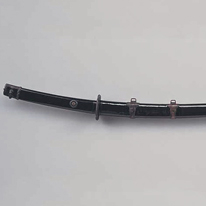Past Exhibitions
- Medieval Sword Mountings: Ornamenting the Samurai
- June 14, 2016 - August 7, 2016
In early Japan, the sword was the symbol of the samurai; however, most people never saw the actual blades that these warriors wore at their waists. Instead, what was visible to the outside world were the decorative mountings (koshirae) in which swords were encased. A sword mounting is made of many components: scabbard, hand guard (tsuba), hilt, and numerous other fittings. These elements were made of various materials including wood, lacquer, textile, and metal, each produced by specialized artisans. The style of a mounting signified the importance of the blade inside. The most elaborate sword mountings were used for ceremonial purposes and served to communicate the rank and class of their wearers. Sometimes important examples were donated as offerings to temples and shrines.
In contrast to ceremonial mountings, the swords used in actual battle were generally housed in mountings that eschewed decoration. These practical mountings, though plain and clunky, often exude a sense of elegance. This exhibition features important sword mountings from medieval Japan including practical mountings for tachi (long swords worn slung from the waist), such as the leather-wrapped and black-lacquered mountings.












